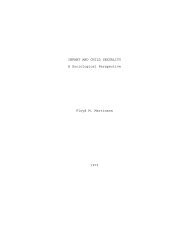1 Social Response to Age-Gap Sex Involving Minors ... - Ipce
1 Social Response to Age-Gap Sex Involving Minors ... - Ipce
1 Social Response to Age-Gap Sex Involving Minors ... - Ipce
Create successful ePaper yourself
Turn your PDF publications into a flip-book with our unique Google optimized e-Paper software.
2<br />
Introduction<br />
In the United States and Great Britain in particular, but also increasingly in other Western<br />
nations, mobilizing against and punishing sex offences involving minors has gone from an<br />
occasional, unsystematic effort some 40 years ago <strong>to</strong> a consuming obsession <strong>to</strong>day. To many,<br />
this change is welcome, based on the belief that age-gap sex with minors is uniquely injurious,<br />
pathological, and criminal. By this thinking, harsh and even extreme measures are often seen as<br />
justified. In the US—on this issue, the trendsetter for the rest of the world—adults involved in<br />
non-coercive sexual episodes with minors, who might have been punished only with probation in<br />
the 1970s, <strong>to</strong>day often receive sentences of decades or more in prison. Those who get out often<br />
face permanent shaming via public registries on the internet, exposing them <strong>to</strong> attacks, threats,<br />
harassment, property damage, and loss of housing and employment. More and more they also<br />
face onerous zoning restrictions that exile them from communities and force them <strong>to</strong> reside in<br />
trailers outside <strong>to</strong>wn or under bridges. 1 To critics, however, this hyper-attention and harsh<br />
response reflects a moral panic built on unfounded assumptions, dubious ideology, invalid<br />
science, media sensationalism, and political pandering. 2 They contend that the response is<br />
becoming more and more inhumane and draconian. Additionally, they complain, the<br />
overreaction is spilling over <strong>to</strong> non-sexual relations between the generations, poisoning them<br />
through the unwarranted suspicions it fosters and weakening them by forcing participants <strong>to</strong> be<br />
artificially distant from one another, much <strong>to</strong> the disadvantage of youths. 3<br />
1 Hubbard, T. (2009). The sex offender system: Punishing homo sacer, the new internal enemy. Unpublished<br />
manuscript. Also, see Appendix for detailed case descriptions and trends in the US.<br />
2 See, for example, Jenkins, P. (1998). Moral panic: Changing concepts of the child-molester in modem America.<br />
New Haven, CT: Yale University Press, and Nathan, D., & Snedeker, M. (1995). Satan's silence: Ritual abuse and<br />
the making of a modem American witchhunt. New York: Basic Books.<br />
3 See, for example, Furedi, F., & Bris<strong>to</strong>w, J. (2008). Licenced <strong>to</strong> hug: How child protection policies are poisoning<br />
the relationship between the generations and damaging the voluntary sec<strong>to</strong>r. London: Civitas, and Russell, J.<br />
(2009). Fear and suspicion are no way <strong>to</strong> build a good society. The Guardian, February 4. Retrieved from:<br />
http://www.guardian.co.uk/commentisfree/2009/feb/04/society-regulation.
















